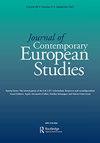国家之间的合作意识。威胁认知和意识形态如何影响欧盟成员国之间的反恐合作
IF 1.8
3区 社会学
Q1 AREA STUDIES
引用次数: 0
摘要
[摘要]影响欧盟成员国双边反恐合作的因素有哪些?虽然学者们对欧洲CT进行了研究,但这个问题仍然需要回答。本文通过引入一个新的理论框架来解决这个问题,该框架结合了CT和外交政策分析(FPA)文献。随着公民威胁意识的增强,政府被迫采取行动。总体而言,中间派内阁倾向于更多地依赖合作协议;同样,在威胁感知的推动下,左翼高管也求助于国际合作。我在一个新收集的数据集上测试了这个框架,该数据集涵盖了2002年至2017年欧盟成员国之间签署的双边CT协议。因此,本文促进了对欧盟CT的研究,重点关注一个较少争论的问题:欧盟成员国之间的双边合作。结果支持了最初的假设,揭示了威胁感知和内阁意识形态对双边CT协议签署数量的强大影响。此外,它们表明,对威胁的感知比恐怖主义的实际影响对合作的影响更大。关键词:反恐合作;外交政策分析;欧盟披露声明作者未报告潜在的利益冲突。https://www.osce.org/resources/documents2。首先,我进行了不同的预估测试。我测试了DV的过度分散和过多的零。两人都缺席了。然后,我测试了自变量。威胁感知和GDP已转换为对数,以避免偏度问题(Balžekienė Citation2019)。其次,对自变量进行单位根检验。政府的意识形态、军警支出和GDP呈现出单位根化的迹象;这样,它的第一个区别就得到了。对这些测试的更深入的解释见附录。这些模型在附录中。本文章由计算机程序翻译,如有差异,请以英文原文为准。
The sense of nations for cooperation. How threat perception and ideology influence counterterrorism cooperation between EU members
ABSTRACTWhich factors influence bilateral counterterrorism (CT) cooperation between EU Member States? Although scholars have studied European CT, the question still needs to be answered. This paper addresses the issue by introducing a new theoretical framework that combines CT and Foreign Policy Analysis (FPA) literature. As citizens’ threat perception increases, governments are pressed to act. Overall, centrist cabinets tend to rely more on cooperation agreements; likewise, pushed by threat perception, left-wing executives also recourse to international cooperation. I tested this framework on a newly collected dataset, which comprehends bilateral CT agreements signed among EU Members from 2002 to 2017. As such, this paper fosters studies on EU CT, focusing on a less debated issue: bilateral cooperation between EU Member States. The results support the initial hypotheses, disclosing a robust influence of threat perception and cabinet ideology on the number of bilateral CT agreements signed. Furthermore, they show that the perception of the threat is more influential on cooperation than the actual impact of terrorism.KEYWORDS: CounterterrorismcooperationForeign Policy AnalysisEuropean Union Disclosure statementNo potential conflict of interest was reported by the author(s).Notes1. https://www.osce.org/resources/documents2. First, I conducted different pre-estimation tests. I tested the DV for overdispersion and an excessive number of zeros. Both were absent. Then, I tested the independent variables. Threat perception and GDP have been transformed in logarithms to avoid skewness problems (Balžekienė Citation2019). Secondly, I tested the independent variables for unit-root. The government’s ideology, military and police expenditure and GDP showed signs of unit-root; thus, its first difference has been taken. A deeper explanation of these tests is in the appendix.3. These models are in the appendix.
求助全文
通过发布文献求助,成功后即可免费获取论文全文。
去求助
来源期刊

Journal of Contemporary European Studies
Multiple-
CiteScore
2.70
自引率
7.70%
发文量
84
期刊介绍:
The Journal of Contemporary European Studies (previously Journal of European Area Studies) seeks to provide a forum for interdisciplinary debate about the theory and practice of area studies as well as for empirical studies of European societies, politics and cultures. The central area focus of the journal is European in its broadest geographical definition. However, the examination of European "areas" and themes are enhanced as a matter of editorial policy by non-European perspectives. The Journal intends to attract the interest of both cross-national and single-country specialists in European studies and to counteract the worst features of Eurocentrism with coverage of non-European views on European themes.
 求助内容:
求助内容: 应助结果提醒方式:
应助结果提醒方式:


